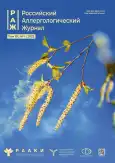Опыт проведения сублингвальной аллергенспецифической терапии у ребёнка с сахарным диабетом
- Авторы: Гайдук И.М.1, Трусова О.В.2, Камаев А.В.2, Аракелян Р.Н.3
-
Учреждения:
- Санкт-Петербургский государственный педиатрический медицинский университет
- Первый Санкт-Петербургский государственный медицинский университет имени академика И.П. Павлова
- Консультативно-диагностический центр № 85
- Выпуск: Том 19, № 1 (2022)
- Страницы: 152-157
- Раздел: Описания клинических случаев
- URL: https://journals.rcsi.science/raj/article/view/121735
- DOI: https://doi.org/10.36691/RJA1525
- ID: 121735
Цитировать
Полный текст
Аннотация
Сезонность обострений поллиноза, широко распространённого в педиатрической популяции, зависит от сроков цветения растений в регионе проживания пациента. С возрастом симптомы пыльцевой аллергии становятся всё более выраженными, развивается пыльцевая бронхиальная астма, снижается эффективность симптоматической терапии, расширяется спектр причинно-значимых аллергенов, что требует персонифицированных эффективных методов лечения.
Случаи проведения аллергенспецифической иммунотерапии у пациентов с сахарным диабетом 1-го типа единичны, поэтому заслуживают особого внимания. Помимо тщательной оценки безопасности проводимой терапии в отношении течения диабета, необходимо уделять внимание преимуществам сублингвальной иммунотерапии, в частности значительному снижению потребности в фармакотерапии обострений, включающей глюкокортикоиды. Конечная цель сублингвальной иммунотерапии ― стойкая безмедикаментозная ремиссия аллергического заболевания в течение нескольких лет по окончании курса лечения.
Представлено описание клинического случая пациента педиатрического возраста (мальчик, 12 лет на момент начала наблюдения) с пыльцевой аллергией (аллергический риноконъюнктивит на пыльцу трав) в сочетании с сахарным диабетом 1-го типа. Обсуждаются критерии инициации аллергенспецифической иммунотерапии у коморбидного пациента (чёткая сезонность обострений, высокие совпадающие результаты аллерготестирования in vivo и in vitro, нарастающие клинические проявления поллиноза в годы перед стартом аллергенспецифической иммунотерапии). Проанализированы возможные риски и зафиксировано отсутствие сахарного диабета как противопоказания к иммунотропному методу лечения. Пациенту проведены два предсезонно-сезонных курса сублингвальной иммунотерапии с аллергенами пыльцы трав в 2020 и 2021 г. с выраженным положительным эффектом. На второй год лечения достигнута ремиссия заболевания: практически полное отсутствие симптомов поллиноза в сезон цветения 2021 г., отсутствие прогрессирования заболевания, значительное снижение потребности в фармакопрепаратах для купирования симптомов. За время проведения терапии у пациента не отмечено ухудшения течения сахарного диабета, сократилась потребность во внеплановом введении короткодействующего инсулина, не связанном с приёмами пищи. Наблюдение пациента продолжается, инициирован третий курс сублингвальной иммунотерапии с аллергенами пыльцы трав.
Таким образом, сублингвальная аллергенспецифическая иммунотерапия безопасна и эффективна в лечении пыльцевой аллергии, рекомендована для проведения в амбулаторных условиях с пятилетнего возраста, особенно показана пациентам с прогрессирующим характером заболевания, при невозможности оградить их от контакта с аллергеном или при недостаточной эффективности стандартной фармакотерапии.
Ключевые слова
Полный текст
Открыть статью на сайте журналаОб авторах
Ирина Михайловна Гайдук
Санкт-Петербургский государственный педиатрический медицинский университет
Автор, ответственный за переписку.
Email: sheveluk@inbox.ru
ORCID iD: 0000-0003-3633-4662
SPIN-код: 5207-5355
д.м.н., профессор кафедры педиатрии им. акад. А.Ф. Тура
Россия, 194100, Санкт-Петербург, ул. Литовская, д. 2Ольга Валерьевна Трусова
Первый Санкт-Петербургский государственный медицинский университет имени академика И.П. Павлова
Email: o-tru@mail.ru
ORCID iD: 0000-0002-0854-1536
SPIN-код: 3938-4377
доцент кафедры терапии госпитальной с курсом аллергологии и иммунологии имени академика Черноруцкого с клиникой, кандидат медицинских наук, доцент
Россия, Санкт-ПетербургАндрей Вячеславович Камаев
Первый Санкт-Петербургский государственный медицинский университет имени академика И.П. Павлова
Email: andykkam@mail.ru
ORCID iD: 0000-0001-9654-3429
SPIN-код: 8554-8565
доцент кафедры общей врачебной практики (семейной медицины), кандидат медицинских наук, доцент
Россия, Санкт-ПетербургРената Николаевна Аракелян
Консультативно-диагностический центр № 85
Email: arakeljanrenata@rambler.ru
ORCID iD: 0000-0002-4544-9923
SPIN-код: 3898-6385
врач аллерголог-иммунолог высшей квалификационной категории
Россия, Санкт-ПетербургСписок литературы
- Зисельсон А.Д. Поллиноз у детей. Ленинград: Медицина, 1989. 160 с.
- Alvaro-Lozano M., Akdis C.A., Akdis M., et al. EAACI Allergen Immunotherapy User’s Guide // Pediatr Allergy Immunol. 2020. Vol. 31, Suppl. 25. P. 1–101. doi: 10.1111/pai.13189
- Pitsios C., Demoly P., Bilo M.B., et al. Clinical contraindications to allergen immunotherapy: an EAACI position paper // Allergy. 2015. Vol. 70, N 8. P. 897–909. doi: 10.1111/all.12638
- Курбачева О.М., Павлова К.С., Галицкая М.А. Клинические противопоказания к АСИТ // Российский аллергологический журнал. 2017. Т. 14, № 2. C. 10–21. doi: 10.36691/RJA319
- Klamt S., Vogel M., Kapellen T.M., et al. Association between IgE-mediated allergies and diabetes mellitus type 1 in children and adolescents // Pediatr Diabetes. 2015. Vol. 16, N 7. P. 493–503. doi: 10.1111/pedi.12298
Дополнительные файлы







